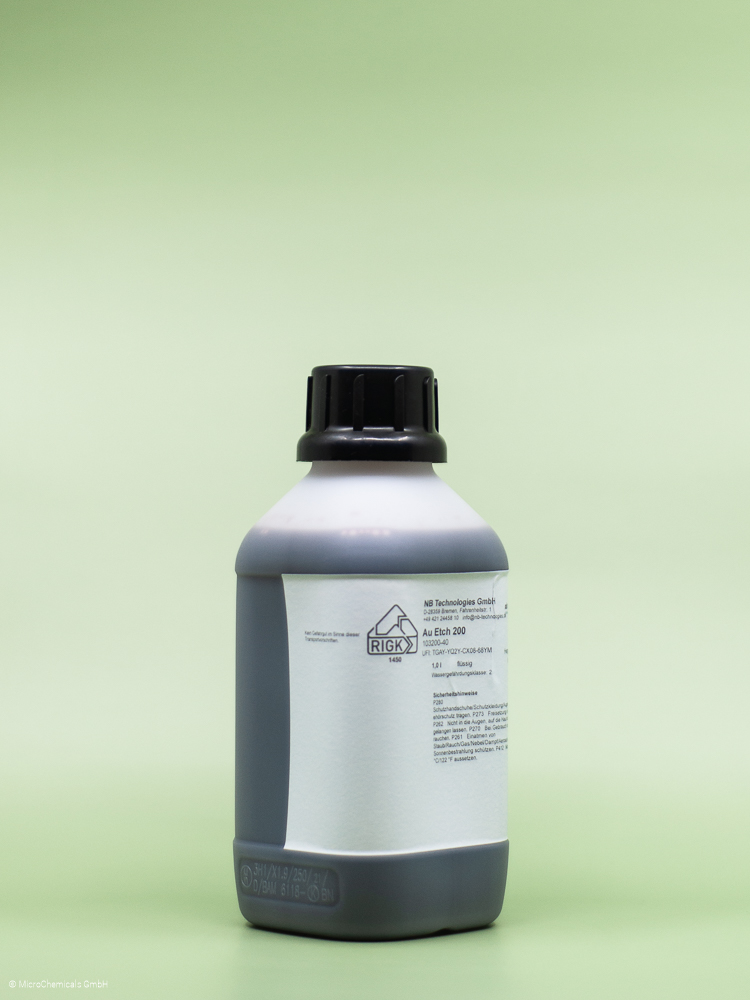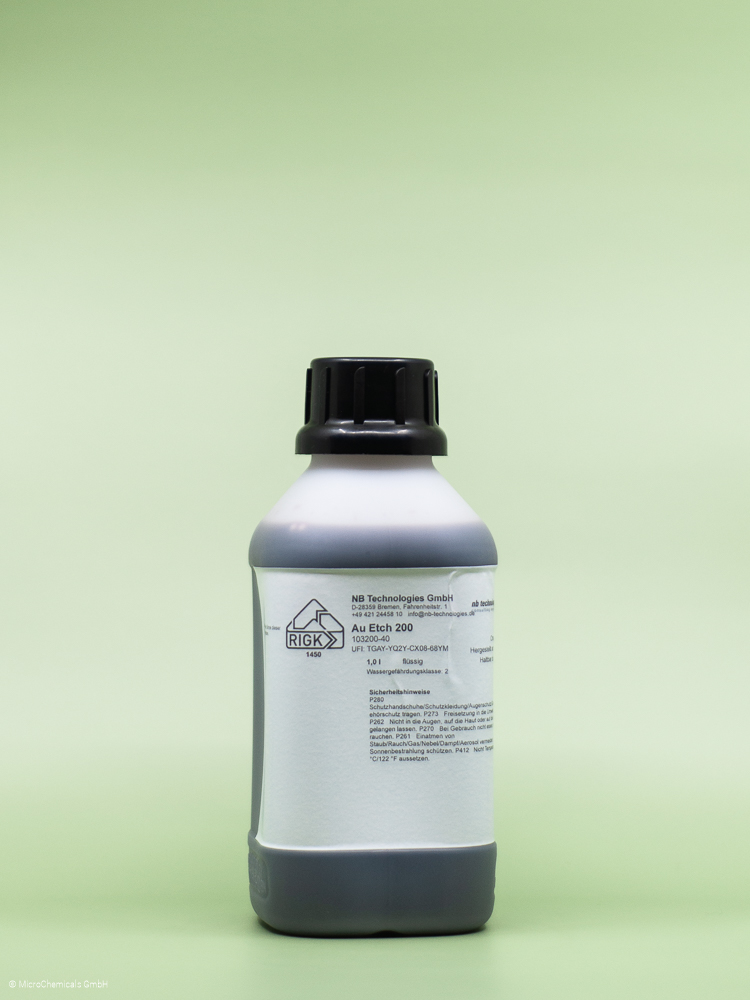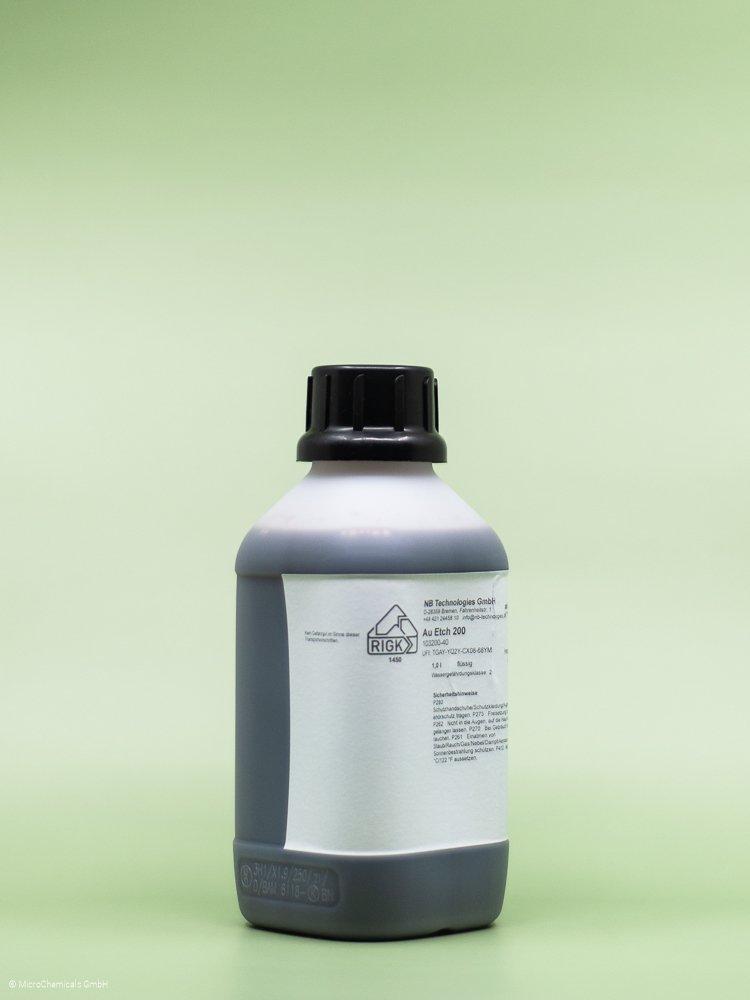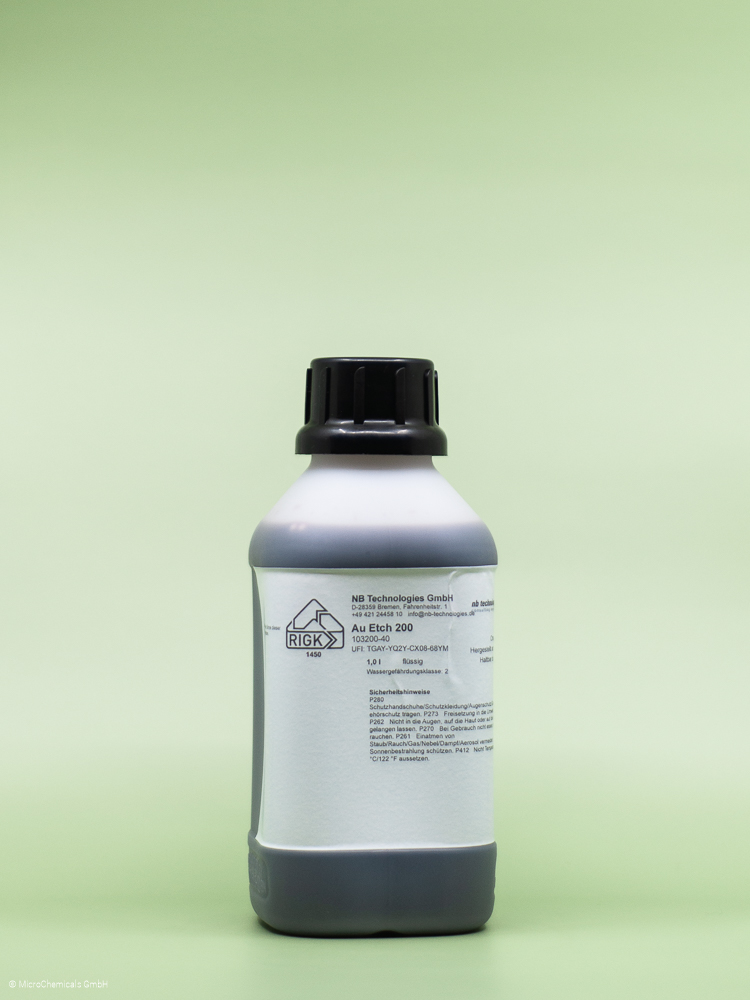ELECTROPLATING
Electrolytes, anodes and additives
In electroforming, metal layers are deposited electrochemically from electrolytes in which the metals are dissolved as ions . In microstructuring, the deposition takes place either through a photoresist mask or on a metallic seed layer structured in advance via a photoresist mask .
> Electroplating: Basics
> Electroplating of Au, Cu, Ni and Ag
Filter products
–
9 Products
NB Semiplate Ag 100 - 1.00 l
nbtag1001
Bottle size:
1.00 l
NB Semiplate AG 100
Silver Plating Solution
General Information
NB Semiplate AG 100 is an alkaline, non-cyanide electroplating formulation, which produces satin bright silver deposits. Deposits from the NB Semiplate AG 100 have excellent physical characteristics such as solder ability and good electrical conductivity.
NOTE:
NB Semiplate AG 100 is a ready-to-use product. It is not necessary to add other materials for the initially start of the application. Over time, it may be necessary depending on the electrolyte and application to add additives (see data sheet).
With adjusted photoresist processing, the NB Semiplate AG 100 is compatible with common AZ®- and TI resists.
Product Properties
Purity: approx. 99.0 – 99.9
Hardness: approx. 70 to 90 HV0,020
Density: approx. 10.4 g/cm3
Further Information
MSDS:
Safety Data Sheet NB Semiplate AG 100 english
Sicherheitsdatenblatt NB Semiplate AG 100 german
TDS:
Technical Data Sheet NB Semiplate AG 100 english
Application Notes:
Instruction NBT Sample Service for Plating Baths english
Anleitung NBT Probenservice für Galvanikbäder german
Plating Theory english
Galvanik Theorie german
Plating and Photoresist english
Galvanik und Fotolacke german
Further Information about Processing
NB Semiplate Au 100 - 1.00 l
nbtau1001
Bottle size:
1.00 l
NB Semiplate AU 100 AS
Gold Plating Solution
General Information
NB Semiplate AU 100 AS is an alkaline, non-cyanide electroplating formulation based on arsenic grain refiner which produces a bright, ductile deposit. In comparison with other gold plating processes, the NB Semiplate AU 100 AS electrolyte demonstrates exceptional throwing power that results in good coverage of recesses, holes and hollows of parts of complex geometry. Deposits from the NB Semiplate AU 100 process also exhibit the unique ability to build brightness with increasing thickness. NB Semiplate AU 100 AS deposits have main applications in MEMS processing.
NB Semiplate AU 100
NOTE:
NB Semiplate AU 100 AS is a ready-to-use product. It is not necessary to add other materials for the initially start of the application. Over time, it may be necessary depending on the electrolyte and application to add additives (see data sheet).
With adjusted photoresist processing, the NB Semiplate AU 100 AS is compatible with common AZ®- and TI resists.
Product Properties
Purity: 99.9%
Hardness: approx. 130 to 190 HV0,020
Contact Resistance: 0.3 mW (measured by cross-wire method with 200 gram load.)
Deposit weight for 2.5 microns: 31.6 mg/in2 (4.9 mg/cm2)(100 µin)
Further Information
MSDS:
Safety Data Sheet NB Semiplate AU 100 AS english
Sicherheitsdatenblatt NB Semiplate AU 100 AS german
TDS:
Technical Data Sheet NB Semiplate AU 100 AS english
Application Notes:
Instruction NBT Sample Service for Plating Baths english
Anleitung NBT Probenservice für Galvanikbäder german
Plating Theory english
Galvanik Theorie german
Plating and Photoresist english
Galvanik und Fotolacke german
Further Information about Processing
NB Semiplate Au 100 TL - 1.00 l
nbtau100TL1
Bottle sizee:
1.00 l
NB Semiplate AU 100 TL
Gold Plating Solution without arsenic
General Information
NB Semiplate AU 100 TL is an alkaline, non-cyanide electroplating formulation which produces a matte to semi-bright, ductile deposit. While the NB Semiplate AU 100 AS product contains arsenic for achieving shiny deposits, the NB Semiplate AU 100 TL is based on thallium and free of arsenic. In comparison with other gold plating processes, the NB Semiplate AU 100 TL electrolyte demonstrates exceptional throwing power that results in good coverage of recesses, holes and hollows of parts of complex geometry. NB Semiplate AU 100 TL deposits have main applications in MEMS processing.
Product:
Brightening agent:
Surface / grain:
NB Semiplate AU 100 TL
thallium
matt to semi-bright / coarse
NB Semiplate AU 100 AS
arsenic
shiny / fine
NB Semiplate AU 100
NOTE:
NB Semiplate AU 100 TL is a ready-to-use product. It is not necessary to add other materials for the initially start of the application. Over time, it may be necessary depending on the electrolyte and application to add additives (see data sheet).
With adjusted photoresist processing, the NB Semiplate AU 100 TL is compatible with common AZ®- and TI resists.
Product Properties
Purity: 99.9%
Hardness: approx. 130 to 190 HV0,020
Contact Resistance: 0.3 mW (measured by cross-wire method with 200 gram load.)
Deposit weight for 2.5 microns: 31.6 mg/in2 (4.9 mg/cm2) (100 µin)
Further Information
MSDS:
Safety Data Sheet NB Semiplate AU 100 TL english
Sicherheitsdatenblatt NB Semiplate AU 100 TL german
TDS:
Technical Data Sheet NB Semiplate AU 100 TL english
Application Notes:
Instruction NBT Sample Service for Plating Baths english
Anleitung NBT Probenservice für Galvanikbäder german
Plating Theory english
Galvanik Theorie german
Plating and Photoresist english
Galvanik und Fotolacke german
Further Information about Processing
NB Semiplate Cu 100 - 1.00 l
nbtcu1001
Bottle size:
1.00 l
NB Semiplate CU 100
Copper Plating Solution
General Information
The NB Semiplate CU 100 process is an acid copper plating formulation engineered for wafer plating applications including copper bump plating, interconnects for VLSI/ULSI or MEMS. The NB Semiplate CU 100 process provides excellent throwing power, improved leveling characteristics, ductile low stress deposits and offers unique flexibility in its operation.
NB Semiplate CU 100
NOTE:
NB Semiplate CU 100 is a ready-to-use product. It is not necessary to add other materials for the initially start of the application. Over time, it may be necessary depending on the electrolyte and application to add additives (see data sheet).
With adjusted photoresist processing, the NB Semiplate CU 100 is compatible with common AZ®- and TI resists.
Further Information
MSDS:
Safety Data Sheet NB Semiplate CU 100 english
Sicherheitsdatenblatt NB Semiplate CU 100 german
TDS:
Technical Data Sheet NB Semiplate CU 100 english
Application Notes:
Instruction NBT Sample Service for Plating Baths english
Anleitung NBT Probenservice für Galvanikbäder german
Plating Theory english
Galvanik Theorie german
Plating and Photoresist english
Galvanik und Fotolacke german
Further Information about Processing
NB Semiplate Cu 150 - 1.00 l
nbtcu1501
NB Semiplate CU 150
Copper Plating Solution
General Information
The NB Semiplate CU 150 process is an acid copper plating formulation engineered for wafer plating applications including copper bump plating, interconnects or MEMS. The NB Semiplate CU 150 process provides excellent throwing power, improved levelling characteristics, ductile low stress deposits and offers unique flexibility in its operation.
This product is specially designed for the operation with inert anode systems without negative impact on plating quality or sensitive compounds such as organic additives. However, the operation using soluble anodes is not excluded.
NB Semiplate CU 150
NOTE:
NB Semiplate CU 150 is a ready-to-use product. It is not necessary to add other materials for the initially start of the application. Over time, it may be necessary depending on the electrolyte and application to add additives (see data sheet).
With adjusted photoresist processing, the NB Semiplate CU 150 is compatible with common AZ®- and TI resists.
Further Information
MSDS:
Safety Data Sheet NB Semiplate CU 150 english
Sicherheitsdatenblatt NB Semiplate CU 150 german
TDS:
Technical Data Sheet NB Semiplate CU 150 english
Application Notes:
Instruction NBT Sample Service for Plating Baths english
Anleitung NBT Probenservice für Galvanikbäder german
Plating Theory english
Galvanik Theorie german
Plating and Photoresist english
Galvanik und Fotolacke german
Further Information about Processing
NB Semiplate In 100 - 1.00 l
nbtin1001
Bottle sizee:
1.00 l
NB Semiplate IN 100
Indium Plating Solution
General Information
The NB Semiplate IN 100 process is an alkaline, non-cyanide indium plating formulation. Deposits obtained from the NB Semiplate IN 100 bath are matte and fine-grained. Throwing power is excellent. The alkaline nature of the bath eliminates the impurity build-up of nickel, iron and copper. NB Semiplate IN 100 deposits have main applications in semiconductor or MEMS processing for bonding purposes, however, standard photo resist products are not applicable/compatible for patterned depositions.
NOTE:
NB Semiplate IN 100 is a ready-to-use product. It is not necessary to add other materials for the initially start of the application. Over time, it may be necessary depending on the electrolyte and application to add additives (see data sheet). With adjusted photoresist processing, the NB Semiplate IN 100 is compatible with common AZ®- and TI resists.
Product Properties
Purity: 99%
Specific gravity (g/cm3): 7.0
For 1 micron deposit (mg/dm2): 70
Further Information
MSDS:
Safety Data Sheet NB Semiplate IN 100 english
Sicherheitsdatenblatt NB Semiplate IN 100 german
TDS:
Technical Data Sheet NB Semiplate IN 100 english
Application Notes:
Instruction NBT Sample Service for Plating Baths english
Anleitung NBT Probenservice für Galvanikbäder german
Plating Theory english
Galvanik Theorie german
Plating and Photoresist english
Galvanik und Fotolacke german
Further Information about Processing
NB Semiplate Ni 100 - 1.00 l - EUD/EVE!
Regular price:
From
€138.00
nbtni1001
Bottle size:
1.00 l
NB Semiplate NI 100
Nickel Plating Solution
General Information
NB Semiplate NI 100 is a nickelsulfamate electroplating process that produces a pure, ductile, fine-grained, semi-bright low stress nickel deposit required to meet the needs of the semiconductor industry for quality assured chemistry. NB Semiplate NI 100 is manufactured to meet the requirements associated with the electroforming of micro patterned wafers (Micro System Technology).
The NB Semiplate NI 100 process contains an anode activating agent in controlled amounts to enhance anode corrosion and prevent anode passivation. Deposit properties are easy to control and maintain.
NB Semiplate NI 100
NOTE:
NB Semiplate NI 100 is a ready-to-use product. It is not necessary to add other materials for the initially start of the application. Over time, it may be necessary depending on the electrolyte and application to add additives (see data sheet).
With adjusted photoresist processing, the NB Semiplate NI 100 is compatible with common AZ®- and TI resists.
Product Properties
Pure nickel depositions
High ductile plating
Fine grained, satin dull deposition
Controllable inner stress of the deposition up to 7000 µm
No anode passivation
High hardness, controllable
Good throwing power
Further Information
MSDS:
Safety Data Sheet NB Semiplate NI 100 english
Sicherheitsdatenblatt NB Semiplate NI 100 german
TDS:
Technical Data Sheet NB Semiplate NI 100 english
Application Notes:
Instruction NBT Sample Service for Plating Baths english
Anleitung NBT Probenservice für Galvanikbäder german
Plating Theory english
Galvanik Theorie german
Plating and Photoresist english
Galvanik und Fotolacke german
Further Information about Processing
NB Semiplate NiMn 100 - 1.00 l - EUD/EVE!
Regular price:
From
€159.00
nbtnimn1001
Bottle size:
1.00 l
NB Semiplate NIMN 100
Nickel-Manganese Plating Solution
General Information
NB Semiplate NIMN 100 is a nickelsulfamate electroplating process, which incorporates small amounts of Mn in the deposit. While properties of pure Ni deposits change dramatically during temperature treatments, the Mn content stabilises the hardness, ductility and yield strength under temperature treatments as high as 600°C. Secondly, such properties do not dramatically change in operation. Therefore, the process is well suited for Ni films used for micro-electromechanical functions, as required for sensors and actuators in microsystem technology.
The process can be operated
for rather columnar growth without grain refiner and rather rough surface condition; this is the ready-to-use product status of NB Semiplate NIMN 100
or for fine-grained films and semi-rough surface using the grain refiner NI 100 ADD. AGENT
NB Semiplate NIMN 100 is manufactured to meet the requirements associated with the electroforming processes for the semiconductor industry and microsystem technology (MST).
The NB Semiplate NIMN 100 process contains an anode activating agent in controlled amounts to enhance anode corrosion and prevent anode passivation. Deposit properties are easy to control and maintain.
NOTE:
NB Semiplate NIMN 100 is a ready-to-use product. It is not necessary to add other materials for the initially start of the application. Over time, it may be necessary depending on the electrolyte and application to add additives (see data sheet).
With adjusted photoresist processing, the NB Semiplate NINM 100 is compatible with common AZ®- and TI resists.
Product Properties
High purity nickel depositions
High stability of mechanical properties under temperature and in operation
High ductility
High hardness
Fine grained or large grained
Medium mechanical stress impact of Mn incorporation (depending on operation condition)
No anode passivation
Good throwing power
Further Information
MSDS:
Safety Data Sheet NB Semiplate NIMN 100 english
Sicherheitsdatenblatt NB Semiplate NIMN 100 german
TDS:
Technical Data Sheet NB Semiplate NIMN 100 english
Application Notes:
Instruction NBT Sample Service for Plating Baths english
Anleitung NBT Probenservice für Galvanikbäder german
Plating Theory english
Galvanik Theorie german
Plating and Photoresist english
Galvanik und Fotolacke german
Further Information about Processing
NB Semiplate Sn 100 - 1.00 l
nbtsn1001
Bottle size:
1.00 l
NB Semiplate SN 100
Tin Plating Solution
General Information
NB Semiplate SN 100 is a high-purity electroplating process which produces fine-grained, matte, pure tin deposits.
It is especially formulated for use in the fabrication of circuit patterns and bumps on semiconductor wafers. The process contains no fluoborates or formaldehyde and is operated with soluble anodes.
NOTE:
NB Semiplate SN 100 is a ready-to-use product. It is not necessary to add other materials for the initially start of the application. Over time, it may be necessary depending on the electrolyte and application to add additives (see data sheet).
With adjusted photoresist processing, the NB Semiplate SN 100 is compatible with common AZ®- and TI resists.
Further Information
MSDS:
Safety Data Sheet NB Semiplate SN 100 english
Sicherheitsdatenblatt NB Semiplate SN 100 german
TDS:
Technical Data Sheet NB Semiplate SN 100 english
Application Notes:
Instruction NBT Sample Service for Plating Baths english
Anleitung NBT Probenservice für Galvanikbäder german
Plating Theory english
Galvanik Theorie german
Plating and Photoresist english
Galvanik und Fotolacke german
Further Information about Processing


















